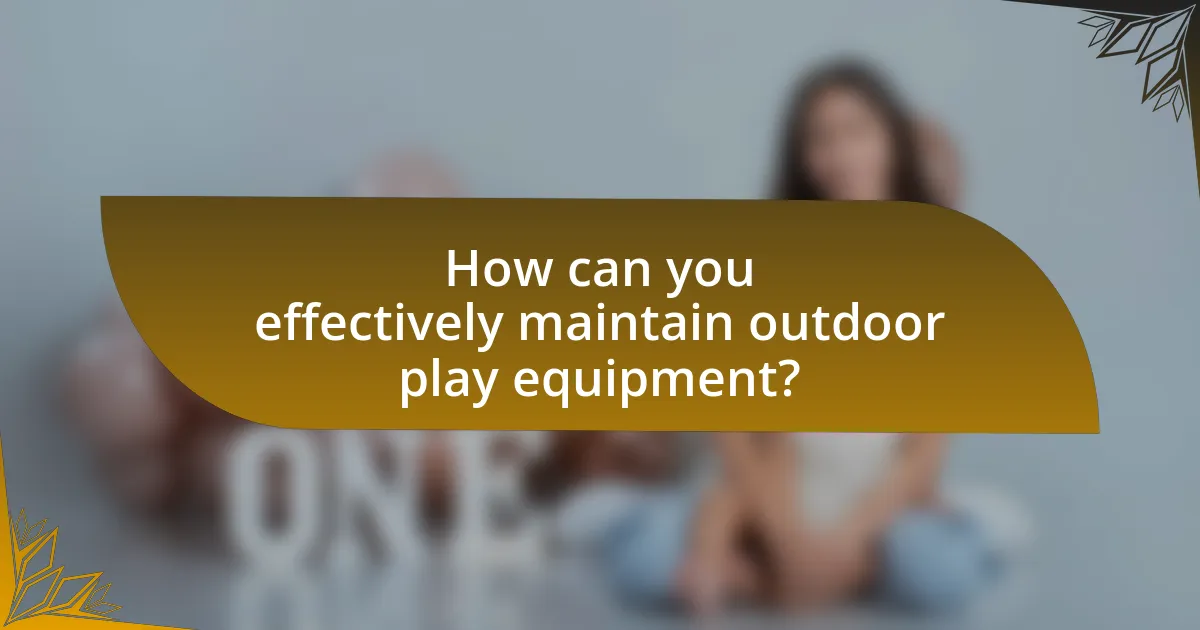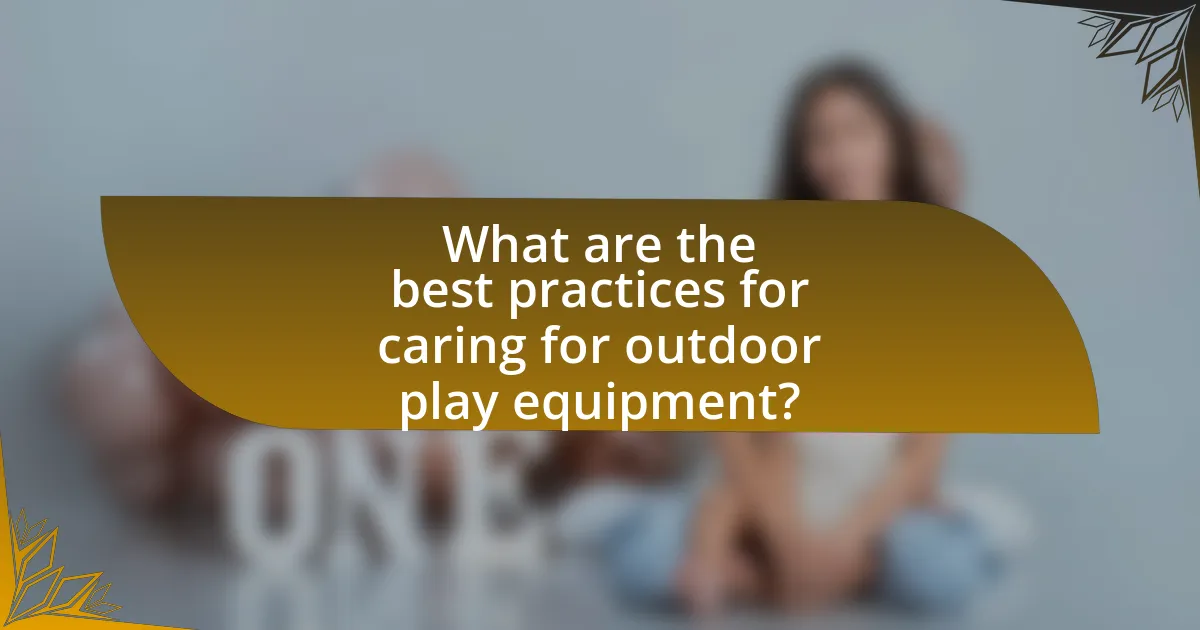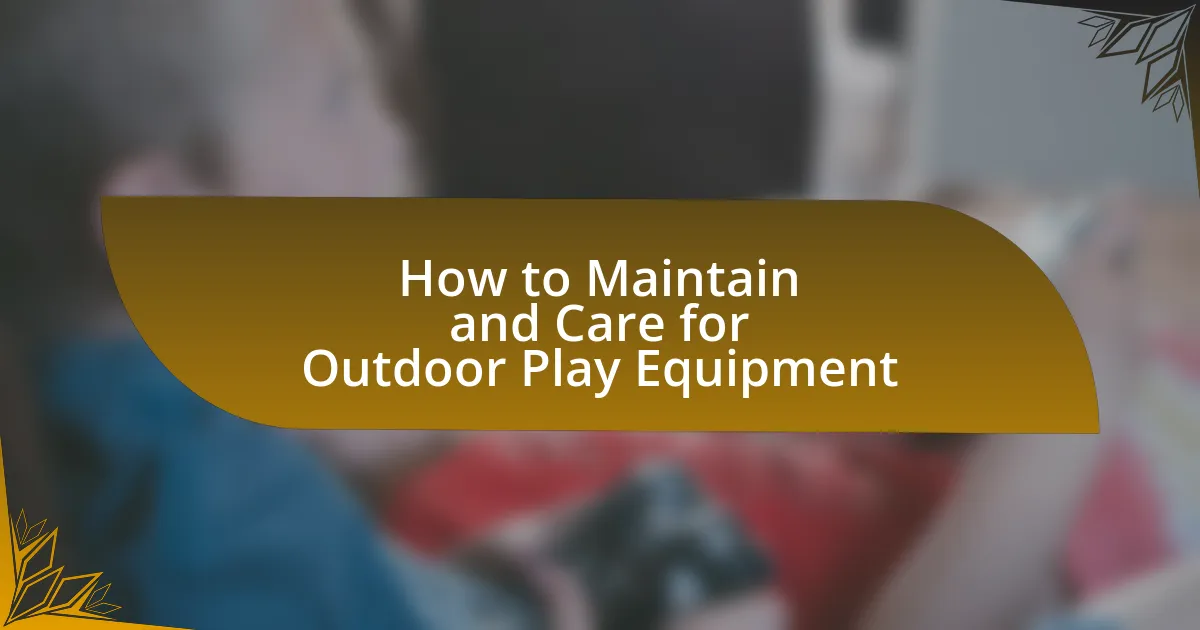Outdoor play equipment maintenance and care is essential for ensuring the safety and longevity of playground structures. This process involves regular inspections, cleaning, and repairs to prevent accidents and injuries, as approximately 200,000 children are treated for playground-related injuries annually in the United States. Key maintenance tasks include checking for wear and tear, tightening loose components, and applying protective coatings, with specific attention to different materials like wood, metal, and plastic. The article outlines best practices for maintaining various types of outdoor play equipment, the importance of seasonal considerations, and troubleshooting tips to address common issues effectively.

What is Outdoor Play Equipment Maintenance and Care?
Outdoor play equipment maintenance and care involves regular inspection, cleaning, and repair of playground structures to ensure safety and longevity. This process includes checking for wear and tear, tightening loose bolts, removing debris, and applying protective coatings to prevent rust and deterioration. According to the U.S. Consumer Product Safety Commission, proper maintenance can significantly reduce the risk of injuries, highlighting the importance of adhering to safety standards and guidelines for outdoor play equipment.
Why is it important to maintain outdoor play equipment?
Maintaining outdoor play equipment is crucial for ensuring the safety and well-being of children. Regular maintenance prevents accidents caused by wear and tear, such as broken swings or unstable climbing structures, which can lead to injuries. According to the Consumer Product Safety Commission, approximately 200,000 children are treated for playground-related injuries each year in the United States, highlighting the importance of proper upkeep. Additionally, well-maintained equipment promotes prolonged use and enjoyment, encouraging physical activity and social interaction among children.
What are the potential risks of neglecting maintenance?
Neglecting maintenance of outdoor play equipment can lead to significant safety hazards, including increased risk of injuries to children. For instance, worn-out surfaces can cause slips and falls, while rusted or broken components may lead to equipment failure during use. According to the Consumer Product Safety Commission, approximately 200,000 children are treated in emergency rooms for playground-related injuries each year, many of which could be prevented through regular maintenance. Additionally, neglect can result in costly repairs or replacements, as minor issues can escalate into major problems if not addressed promptly.
How does regular maintenance enhance safety and longevity?
Regular maintenance enhances safety and longevity by ensuring that outdoor play equipment remains in optimal condition, reducing the risk of accidents and extending its usable life. Regular inspections can identify wear and tear, such as rust, loose bolts, or damaged surfaces, which, if left unaddressed, could lead to injuries. For instance, a study by the American Society for Testing and Materials found that playgrounds with consistent maintenance had 30% fewer reported injuries compared to those with irregular upkeep. This proactive approach not only safeguards children but also maximizes the investment in the equipment, ensuring it serves its purpose effectively over time.
What types of outdoor play equipment require maintenance?
Outdoor play equipment that requires maintenance includes swings, slides, climbing structures, and trampolines. These types of equipment are subject to wear and tear from regular use and environmental factors. For instance, swings may need regular inspection for frayed ropes or damaged seats, while slides can develop cracks or become slippery due to weather conditions. Climbing structures often require checks for rust or loose bolts, and trampolines need to be examined for torn mats or weakened springs. Regular maintenance ensures safety and prolongs the lifespan of the equipment.
How do different materials affect maintenance needs?
Different materials significantly influence the maintenance needs of outdoor play equipment. For instance, wooden structures require regular sealing and treatment to prevent rot and insect damage, while metal components may need periodic rust prevention and painting to maintain their integrity. Plastic materials, on the other hand, typically require less maintenance but can fade or become brittle over time due to UV exposure. Research indicates that wood can last 10-15 years with proper care, while metal can last indefinitely with adequate maintenance, highlighting the varying longevity and upkeep requirements based on material choice.
What are the common types of outdoor play equipment?
Common types of outdoor play equipment include swings, slides, climbing structures, seesaws, and merry-go-rounds. Swings provide a dynamic way for children to experience motion, while slides offer a thrilling descent. Climbing structures encourage physical activity and coordination, seesaws promote balance and teamwork, and merry-go-rounds facilitate group play. These equipment types are widely recognized in playgrounds and are essential for promoting active play among children.

How can you effectively maintain outdoor play equipment?
To effectively maintain outdoor play equipment, regularly inspect the equipment for wear and tear, ensuring all components are secure and functioning properly. This includes checking for rust, loose bolts, and damaged surfaces. According to the Consumer Product Safety Commission, routine maintenance can prevent accidents and prolong the lifespan of the equipment. Additionally, cleaning the equipment with non-toxic cleaners helps remove dirt and debris that can cause deterioration. Regular maintenance schedules, ideally every few months, are recommended to ensure safety and compliance with safety standards.
What are the essential maintenance tasks for outdoor play equipment?
Essential maintenance tasks for outdoor play equipment include regular inspections, cleaning, lubrication, and repairs. Regular inspections should be conducted to identify any wear and tear, loose parts, or safety hazards, ensuring that the equipment remains safe for use. Cleaning involves removing debris, dirt, and any potential hazards from the play area, which helps maintain a safe environment. Lubrication of moving parts, such as swings and slides, prevents rust and ensures smooth operation. Additionally, timely repairs of any damaged components are crucial to prevent accidents and prolong the lifespan of the equipment. These tasks are supported by safety guidelines from organizations like the Consumer Product Safety Commission, which emphasize the importance of maintaining play equipment to reduce injury risks.
How often should inspections be conducted?
Inspections of outdoor play equipment should be conducted at least once a month. Regular monthly inspections help identify wear and tear, safety hazards, and maintenance needs, ensuring the equipment remains safe for use. According to the U.S. Consumer Product Safety Commission, frequent inspections are crucial for preventing accidents and injuries, as they allow for timely repairs and maintenance.
What specific cleaning methods are recommended?
Recommended cleaning methods for outdoor play equipment include pressure washing, using a mild soap solution, and applying disinfectants. Pressure washing effectively removes dirt and debris from surfaces, while a mild soap solution can be used to scrub down equipment, ensuring that any grime is eliminated. Disinfectants, particularly those that are safe for outdoor use, help to kill germs and bacteria, promoting a healthier play environment. Regular cleaning, ideally every few months or after heavy use, is essential to maintain the equipment’s safety and longevity.
What tools and supplies are needed for maintenance?
To maintain outdoor play equipment, essential tools and supplies include a screwdriver set, wrenches, pliers, a hammer, a level, a tape measure, and safety gear such as gloves and goggles. These tools facilitate the inspection, tightening, and repair of various components, ensuring the equipment remains safe and functional. Additionally, supplies like lubricant, cleaning agents, and replacement parts (such as bolts and screws) are necessary for upkeep. Regular maintenance using these tools and supplies helps prevent accidents and prolongs the lifespan of the equipment.
Which cleaning agents are safe for outdoor play equipment?
Vinegar and mild dish soap are safe cleaning agents for outdoor play equipment. Vinegar is a natural disinfectant that effectively removes dirt and grime without harmful chemicals, making it suitable for children’s play areas. Mild dish soap, when diluted with water, can clean surfaces without leaving toxic residues. Both options are non-toxic and environmentally friendly, ensuring safety for children during play.
What tools are essential for repairs and upkeep?
Essential tools for repairs and upkeep of outdoor play equipment include a wrench set, screwdriver set, pliers, a hammer, a level, and a tape measure. These tools are necessary for tightening bolts, replacing screws, adjusting components, and ensuring proper alignment. For instance, a wrench set allows for the secure fastening of nuts and bolts, which is critical for the stability of play structures. A screwdriver set is essential for replacing or tightening screws that hold various parts together. Pliers can be used for gripping and bending materials, while a hammer is useful for driving nails or adjusting misaligned parts. A level ensures that equipment is installed correctly, preventing safety hazards, and a tape measure is vital for accurate measurements during installation or repairs.

What are the best practices for caring for outdoor play equipment?
The best practices for caring for outdoor play equipment include regular inspections, cleaning, and maintenance. Regular inspections should occur at least once a month to identify any wear and tear, loose parts, or safety hazards. Cleaning the equipment with mild soap and water helps remove dirt and debris, preventing deterioration. Additionally, applying protective coatings, such as rust inhibitors for metal parts and sealants for wooden structures, can extend the lifespan of the equipment. Proper anchoring and ensuring that the surface beneath the equipment is safe and appropriate, such as using mulch or rubber mats, also contribute to safety and longevity. These practices are supported by guidelines from organizations like the American Society for Testing and Materials, which emphasize the importance of routine maintenance for safety and durability.
How can you ensure the safety of outdoor play equipment?
To ensure the safety of outdoor play equipment, conduct regular inspections and maintenance. Regular inspections should include checking for structural integrity, ensuring that surfaces are free from hazards, and verifying that all components are securely fastened. According to the U.S. Consumer Product Safety Commission, approximately 200,000 children are treated for playground-related injuries each year, highlighting the importance of proper maintenance. Implementing a routine maintenance schedule can significantly reduce risks and enhance the safety of play equipment.
What signs indicate that equipment needs repair or replacement?
Signs that indicate equipment needs repair or replacement include visible damage such as cracks, rust, or corrosion, which compromise structural integrity. Additionally, unusual noises during operation, decreased performance, or frequent breakdowns signal that maintenance is required. Regular inspections revealing worn-out parts or safety hazards, such as sharp edges or unstable structures, further confirm the need for repair or replacement. According to the Consumer Product Safety Commission, maintaining outdoor play equipment is crucial for safety, as damaged equipment can lead to accidents and injuries.
How can you prevent wear and tear on outdoor play equipment?
To prevent wear and tear on outdoor play equipment, regular maintenance is essential. This includes routine inspections to identify and address any damage, such as rust, loose bolts, or splintered wood, which can compromise safety and longevity. Additionally, applying protective coatings, such as weather-resistant sealants, can shield surfaces from the elements, reducing deterioration. Keeping the area around the equipment clear of debris and ensuring proper drainage can also minimize wear caused by environmental factors. Regular cleaning with appropriate materials helps maintain the equipment’s integrity and appearance, further extending its lifespan.
What seasonal considerations should be taken into account?
Seasonal considerations for maintaining and caring for outdoor play equipment include weather impacts, temperature fluctuations, and seasonal usage patterns. For instance, during winter, snow and ice can cause structural damage or create hazardous conditions, necessitating regular inspections and snow removal. In spring, increased rainfall can lead to rust and corrosion, requiring protective coatings and drainage solutions. Summer heat can cause materials to warp or fade, prompting checks for UV protection and surface integrity. Finally, fall leaves can accumulate and obstruct drainage, necessitating regular cleaning to prevent water damage. These considerations ensure the safety and longevity of outdoor play equipment throughout the year.
How does weather impact the maintenance of outdoor play equipment?
Weather significantly impacts the maintenance of outdoor play equipment by influencing the rate of wear and tear on materials. For instance, prolonged exposure to rain can lead to rust on metal components, while intense sunlight can cause plastic parts to fade and become brittle. Additionally, extreme temperatures can affect the integrity of wood, making it prone to cracking or splintering. Regular inspections and maintenance schedules must account for these weather-related factors to ensure safety and longevity of the equipment.
What specific tasks should be performed before and after winter?
Before winter, outdoor play equipment should be thoroughly cleaned, inspected for damage, and properly stored if possible. Cleaning removes dirt and debris that can cause deterioration, while inspection identifies any repairs needed to ensure safety. Proper storage protects the equipment from harsh winter conditions, extending its lifespan.
After winter, the equipment should be cleaned again to remove any accumulated snow, ice, or debris, and inspected for any damage that may have occurred during the winter months. This ensures that the equipment is safe and ready for use in the spring. Regular maintenance checks, including tightening bolts and lubricating moving parts, should also be performed to maintain functionality and safety.
What are some common troubleshooting tips for outdoor play equipment?
Common troubleshooting tips for outdoor play equipment include checking for loose bolts and screws, inspecting for rust or corrosion, ensuring surfaces are free from debris, and verifying that safety features are functioning properly. Regularly tightening bolts and screws prevents structural instability, while addressing rust can prolong the equipment’s lifespan. Cleaning surfaces helps maintain safety and usability, and testing safety features, such as swings and slides, ensures they operate correctly, reducing the risk of injury. These practices are essential for maintaining the integrity and safety of outdoor play equipment.
How can you identify and fix common issues?
To identify and fix common issues with outdoor play equipment, regularly inspect the equipment for visible damage, wear, or rust. This includes checking for loose bolts, cracked plastic, or splintered wood, which can compromise safety. For instance, a study by the American Society for Testing and Materials indicates that regular inspections can reduce accidents by up to 50%. Once issues are identified, repair them promptly by tightening loose parts, replacing damaged components, or applying protective coatings to prevent further deterioration.
What resources are available for further assistance with maintenance?
For further assistance with maintenance of outdoor play equipment, resources include manufacturer guidelines, maintenance manuals, and online support forums. Manufacturer guidelines provide specific instructions tailored to the equipment, ensuring proper care and maintenance practices. Maintenance manuals often contain detailed procedures, safety checks, and troubleshooting tips relevant to various types of play equipment. Online support forums allow users to share experiences and solutions, fostering a community of knowledge around maintenance issues. These resources collectively enhance the ability to maintain outdoor play equipment effectively.
